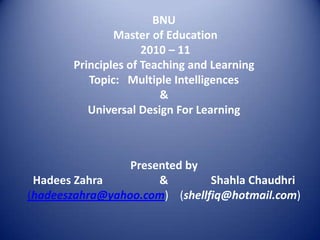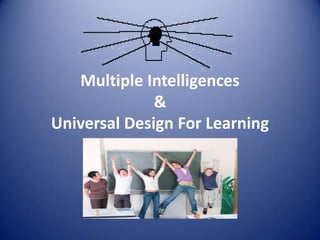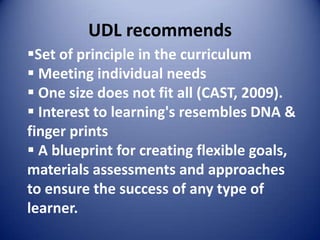Multiple intelligences
- 1. BNU Master of Education 2010 â 11 Principles of Teaching and LearningTopic: Multiple Intelligences&Universal Design For LearningPresented by Hadees Zahra & ShahlaChaudhri(hadeeszahra@yahoo.com) (shellfiq@hotmail.com)
- 2. Multiple Intelligences&Universal Design For Learning
- 3. ObjectivesHoward Gardnerâs Theory of Multiple IntelligencesGardnerâs eight domains of intelligencesWhat is UDL?In the UDL classroom, you will see:Multiple Intelligences Vs Universal Design for Learning How to use Multiple Intelligences in schoolA TYPICAL MI CLASSROOM has:Sternbergâs triarchic of intelligenceMI â issues and problemsConclusionWorks Cited
- 4. Howard Gardnerâs Theory of Multiple Intelligences the traditional notion of intelligence, based on I.Q. testing, is far too limited
- 5. Gardnerâs eight domains of intelligences
- 6. In 1999, two more domains spiritual& existential intelligencesGardnerâs eight domains of intelligences
- 7. What is UDL?In todayâs classroom, diversity is more and more prevalent each and every day. Classroom teachers face the following challenges in education: English language barriers Behavior and emotional problems Lack of interest in education Sensory, physical, or learning disabilities
- 8. Set of principle in the curriculum
- 9. Meeting individual needs
- 10. One size does not fit all (CAST, 2009).
- 11. Interest to learning's resembles DNA & finger prints
- 12. A blueprint for creating flexible goals, materials assessments and approaches to ensure the success of any type of learner.UDL recommends
- 13. In the UDL classroom, you will see:multiple methods to solve any probleminformation presented in multiple mediumsalternate assessments to demonstrate new learninggoal setting appropriate to each learnermaterials that meet the needs each learnerstudent-centered learning
- 14. Multiple Intelligences Vs Universal Design for Learning
- 15. How to use Multiple Intelligences in school Attend to all intelligences not just the traditional valued too
- 16. Students need to have extended opportunities to work on a topic
- 17. Develop flexible programmes Multiple means of assessments Acting on the belief that diverse students can learn and succeed
- 18. Reflect on what worked, what didnât and rework it for next time. A TYPICAL MI CLASSROOM has: engaged students
- 19. choices
- 20. portfolios for all students for all subjects
- 21. art centers
- 22. technology
- 24. dioramas, projects, and multi-media presentations Sternbergâs triarchic of intelligenceAnalytic (thinking)Creative (responding to new experiences)Practical (coping with everyday situation)
- 25. MI â issues and problemsAre the criteria Gardnerâs employs adequate?Does Gardnerâs conceptualization of intelligence hold together? Is there sufficient empirical evidence to support Gardnerâs conceptualization ?
- 26. Conclusionutility in educationeducators dominant discourses of skilling , curriculum and testingMindy Kornhaberâs project SUMIT significant gains in SATmetaphor of Compass pointsmarkers (culture,readiness,tool,collaboration, choice and art)
- 30. http://www.pz.harvard.edu/Research/MISchool.htm http://www.cast.org/research/udl/index.html














